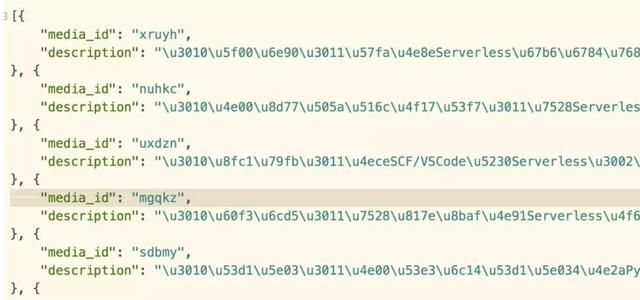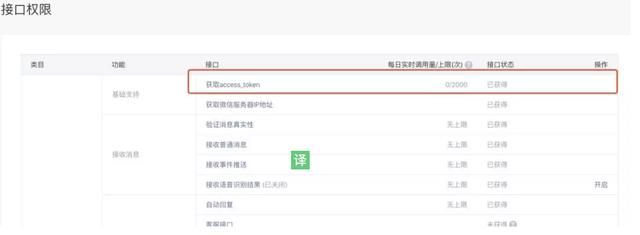python 开发公众号sdk_「公众号开发」基于Serverless架构Python实现公众号图文搜索...
大家都看到了,这是一个全新的公众号,而我,目前也在疯狂的写Serverless架构的各种实战化教程:为什么不拿这个公众号开刀呢?是的,在过去的日子中,我发了两个工程化项目:
- AI_Album:一个Python开发的人工智能相册系统,搭建在Serverless架构上;
- ServerlessBlog:一个Python开发的Serverless博客系统,前台接口是原生开发,后台是一个Flask框架部署在函数计算上。
我为什么要做这样的工程化例子呢?因为我发现,Serverless架构真的很好用,但是最佳实践却很少。尤其是工程化的例子更是少的可怜。做了小程序、做了CMS,我的第三个实践案例就是公众号的开发。
在之前的文章中,已经和大家分享了如何快速简单的上手公众号开发:
今天将和大家在这个基础上,开始第一个模块的开发:文章搜索功能。
首先要说为什么要做文章搜索功能?
因为用户,不知道我们发了什么文章,也不清楚每个文章具体内容,他可能只需要简单的关键词,来看一下这个公众号是否有他想要的东西,例如他搜索:如何上传文件?或者搜索:如何开发Component?这样简单的问题,就可以快速把最相关的历史文章推送给用户,这将会是很方便的一件事情(别管这个是不是伪需求,主要目的是要开发一个有趣的公众号,通过这个公众号的开发,让大家对Serverless架构更加了解和熟悉。)
先简单的来看一下效果图:
是的,通过这样简单的问题描述,找到目标结果,表面上这是一个文章搜索功能,实际上可以把它拓展成是一种“客服系统”。甚至将其升级为一种“聊天系统”,当然这些都是后话。
在上一节课的基础上,我们新增两个函数:
函数1: 索引建立函数
主要功能:通过触发该函数,可以将现有的公众号数据进行整理,并且建立适当的索引文件,存储到COS中。
# -*- coding: utf8 -*-import osimport reimport jsonimport randomfrom snownlp import SnowNLPfrom qcloud_cos_v5 import CosConfigfrom qcloud_cos_v5 import CosS3Clientbucket = os.environ.get('bucket')secret_id = os.environ.get('secret_id')secret_key = os.environ.get('secret_key')region = os.environ.get('region')client = CosS3Client(CosConfig(Region=region, SecretId=secret_id, SecretKey=secret_key))def main_handler(event, context): response = client.get_object( Bucket=bucket, Key=event["key"], ) response['Body'].get_stream_to_file('/tmp/output.txt') with open('/tmp/output.txt') as f: data = json.loads(f.read()) articlesIndex = [] articles = {} tempContentList = [ "_", " ", ] for eveItem in data: for i in range(0, len(eveItem['content']['news_item'])): content = eveItem['content']['news_item'][i]['content'] content = re.sub(r'', '_', content) content = re.sub(r'<.>', '', content) for eve in tempContentList: content = content.replace(eve, "") if "Serverless实践列表" in content: content = content.split("Serverless实践列表")[i] desc = "%s。%s。%s" % ( eveItem['content']['news_item'][i]['title'], eveItem['content']['news_item'][i]['digest'], "。".join(SnowNLP(content).summary(3)) ) tempKey = "".join(random.sample('zyxwvutsrqponmlkjihgfedcba', 5)) articlesIndex.append( { "media_id": tempKey, "description": desc } ) articles[tempKey] = eveItem['content']['news_item'][i] client.put_object( Bucket=bucket, Body=json.dumps(articlesIndex).encode("utf-8"), Key=event['index_key'], EnableMD5=False ) client.put_object( Bucket=bucket, Body=json.dumps(articles).encode("utf-8"), Key=event['key'], EnableMD5=False )这一部分,可能定制化比较多一些,首先是tempContentList变量,这个部分是因为我的很多公众号都会有开始的这样一句话,所以为了建立索引比较准确,我将一些可能影响结果的话去掉。然后我还通过上述代码去掉了code标签里面的内容,因为代码也会影响结果,同时我还去掉了html标签。
原始的文件大概是这样的:
处理好的文件(通过标题+描述+SnowNLP提取的摘要):
然后这些文件存储到COS中:
这一部分的核心就是,正确让我们提取出来的description尽可能的可以准确的描述文章的内容。一般情况下,标题就是文章的核心,但是标题可能有一些信息丢失,例如说文章:【想法】用Tencent云Serverless你要知道他们两个的区别实际上描述的是Plugin和Component的区别,虽然标题知道是两个东西,但是却缺少了核心的目标,所以再加上我们下面的描述:什么是Serverless Framework Plugin?什么是Component?Plugin与Component有什么区别?想要入门Serverless CLI,这两个产品必须分的清楚,本文将会分享这二者区别与对应的特点、功能。当然,加上描述之后内容变得已经相当精确,但是正文中,可能有相对来说更加精准的描述或者额外的内容,所以采用的是标题+描述+摘要(textRank提取出来的前三句,属于提取式文本)。
函数2: 搜索函数
主要功能:当用户向微信号发送了指定关键词,通过该函数获取的结果。
思考:函数1和函数2,都可以集成在之前的函数中,为什么要把函数1和函数2单独拿出来做一个独立的函数存在呢?放在一个函数中不好么?
是这样的,主函数触发次数相对来说是最多的,而且这个函数本身不需要太多的资源配置(64M就够了),而函数1和函数2,可能需要消耗更多的资源,如果三个函数合并放在一起,可能函数的内存大小需要整体调大,满足三个函数需求,这样的话,相对来说会消耗更多资源,例如主函数触发了10次(64M,每次1S),函数1触发了2次(512M,每次5S),函数2触发了4次(384M,每次3S)
如果将三个函数放在一起,资源消耗是:
如果将其变成三个函数来执行,资源消耗是:
前者总计资源消耗13308,后者10432,随着调用次数越来越多,主函数的调用比例会越来越大,所以节约的资源也就会越来越多,所以此处建议将资源消耗差距比较大的模块,分成不同函数进行部署。
import osimport jsonimport jiebafrom qcloud_cos_v5 import CosConfigfrom qcloud_cos_v5 import CosS3Clientfrom collections import defaultdictfrom gensim import corpora, models, similaritiesbucket = os.environ.get('bucket')secret_id = os.environ.get('secret_id')secret_key = os.environ.get('secret_key')region = os.environ.get('region')client = CosS3Client(CosConfig(Region=region, SecretId=secret_id, SecretKey=secret_key))def main_handler(event, context): response = client.get_object( Bucket=bucket, Key=event["key"], ) response['Body'].get_stream_to_file('/tmp/output.txt') with open('/tmp/output.txt') as f: data = json.loads(f.read()) articles = [] articlesDict = {} for eve in data: articles.append(eve['description']) articlesDict[eve['description']] = eve['media_id'] sentence = event["sentence"] documents = [] for eve_sentence in articles: tempData = " ".join(jieba.cut(eve_sentence)) documents.append(tempData) texts = [[word for word in document.split()] for document in documents] frequency = defaultdict(int) for text in texts: for word in text: frequency[word] += 1 dictionary = corpora.Dictionary(texts) new_xs = dictionary.doc2bow(jieba.cut(sentence)) corpus = [dictionary.doc2bow(text) for text in texts] tfidf = models.TfidfModel(corpus) featurenum = len(dictionary.token2id.keys()) sim = similarities.SparseMatrixSimilarity( tfidf[corpus], num_features=featurenum )[tfidf[new_xs]] answer_list = [(sim[i], articles[i]) for i in range(1, len(articles))] answer_list.sort(key=lambda x: x[0], reverse=True) result = [] print(answer_list) for eve in answer_list: if eve[0] > 0.10: result.append(articlesDict[eve[1]]) if len(result) >= 8: result = result[0:8] return {"result": json.dumps(result)}这一部分的代码也是很简单,主要是通过文本的相似度对每个文本进行评分,然后按照评分从高到低进行排序,给定一个阈值(此处设定的阈值为0.1),输出阈值之前的数据。
另外这里要注意,此处引用了两个依赖是jieba和gensim,这两个依赖都可能涉及到二进制文件,所以强烈推荐在CentOS系统下进行打包。当然,如果没有CentOS的小伙伴也可以尝试我的打包工具:
(小声BB:我是MacOS,我就是在自己做的这个网页上打包之后,下载到本地,放进去的,完美,自己做的东西先满足了自己的需求,嘻嘻)
接下来就是主函数中的调用,为了实现上述功能,需要在主函数中新增方法:
1: 获取全部图文消息
def getTheTotalOfAllMaterials(): ''' :return: ''' accessToken = getAccessToken() if not accessToken: return "Get Access Token Error" url = "公众号url/cgi-bin/material/get_materialcount?access_token=%s" % accessToken responseAttr = urllib.request.urlopen(url=url) return json.loads(responseAttr.read())def getMaterialsList(listType, count): ''' :return: ''' accessToken = getAccessToken() if not accessToken: return "Get Access Token Error" url = "公众号url/cgi-bin/material/batchget_material?access_token=%s" % accessToken materialsList = [] for i in range(1, int(count / 20) + 2): requestAttr = urllib.request.Request(url=url, data=json.dumps({ "type": listType, "offset": 20 * (i - 1), "count": 20 }).encode("utf-8"), headers={ "Content-Type": "application/json" }) responseAttr = urllib.request.urlopen(requestAttr) responseData = json.loads(responseAttr.read().decode("utf-8")) materialsList = materialsList + responseData["item"] return materialsList可以通过以下代码调用:
rticlesList = getMaterialsList("news", getTheTotalOfAllMaterials()['news_count'])2: 将图文消息存储到COS,并且通过函数的Invoke接口,实现函数间调用:
def saveNewsToCos(): global articlesList articlesList = getMaterialsList("news", getTheTotalOfAllMaterials()['news_count']) try: cosClient.put_object( Bucket=bucket, Body=json.dumps(articlesList).encode("utf-8"), Key=key, EnableMD5=False ) req = models.InvokeRequest() params = '{"FunctionName":"Weixin_GoServerless_GetIndexFile", "ClientContext":"{"key": "%s", "index_key": "%s"}"}' % ( key, indexKey) req.from_json_string(params) resp = scfClient.Invoke(req) resp.to_json_string() response = cosClient.get_object( Bucket=bucket, Key=key, ) response['Body'].get_stream_to_file('/tmp/content.json') with open('/tmp/content.json') as f: articlesList = json.loads(f.read()) return True except Exception as e: print(e) return False3: 根据搜索反馈回来的Key实现文章内容的对应
def searchNews(sentence): req = models.InvokeRequest() params = '{"FunctionName":"Weixin_GoServerless_SearchNews", "ClientContext":"{"sentence": "%s", "key": "%s"}"}' % ( sentence, indexKey) req.from_json_string(params) resp = scfClient.Invoke(req) print(json.loads(json.loads(resp.to_json_string())['Result']["RetMsg"])) media_id = json.loads(json.loads(json.loads(resp.to_json_string())['Result']["RetMsg"])["result"]) return media_id if media_id else None最后在main_handler中,增加使用逻辑:
逻辑很简答,就是根据用户发的消息,去查找对应的结果,拿到结果之后判断结果个数,如果有1个相似内容,则返回一个图文,如果有多个则返回带有链接的文本。
另外一个逻辑是建立索引,直接是通过API网关触发即可,当然,如果怕不安全或者有需要的话,可以增加权限坚定的参数:
额外优化:
在接口列表中,我们可以看到获取accessToken的接口实际上是有次数限制的,每次获取有效期两个小时。所以,我们就要在函数中,对这部分内容做持久化。为了这个小东西,弄一个MySQL貌似不是很划算,所以决定用COS:
def getAccessToken(): ''' 正常返回:{"access_token":"ACCESS_TOKEN","expires_in":7200} 异常返回:{"errcode":40013,"errmsg":"invalid appid"} :return: ''' global accessToken # 第一次判断是判断本地是否已经有了accessToken,考虑到容器复用情况 if accessToken: if int(time.time()) - int(accessToken["time"]) <= 7000: return accessToken["access_token"] # 如果本地没有accessToken,可以去cos获取 try: response = cosClient.get_object( Bucket=bucket, Key=accessTokenKey, ) response['Body'].get_stream_to_file('/tmp/token.json') with open('/tmp/token.json') as f: accessToken = json.loads(f.read()) except: pass # 这一次是看cos中是否有,如果cos中有的话,再次进行判断段 if accessToken: if int(time.time()) - int(accessToken["time"]) <= 7000: return accessToken["access_token"] # 如果此时流程还没停止,则说明accessToken还没获得到,就需要从接口获得,并且同步给cos url = "公众号url/cgi-bin/token?grant_type=client_credential&appid=%s&secret=%s" % (appid, secret) accessTokenResult = json.loads(urllib.request.urlopen(url).read().decode("utf-8")) accessToken = {"time": int(time.time()), "access_token": accessTokenResult["access_token"]} print(accessToken) response = cosClient.put_object( Bucket=bucket, Body=json.dumps(accessToken).encode("utf-8"), Key=accessTokenKey, EnableMD5=False ) return None if "errcode" in accessToken else accessToken["access_token"]当然,我觉得这段代码可以继续优化,但是目前这个算是一个思路。
最后上一下Yaml:
Conf: component: "serverless-global" inputs: region: ap-shanghai bucket: go-serverless-1256773370 wxtoken: 小程序Token appid: 小程序appid secret: 小程序密钥 secret_id: Tencent云SecretId secret_key: Tencent云SecretKeyWeixin_Bucket: component: '@gosls/tencent-cos' inputs: bucket: ${Conf.bucket} region: ${Conf.region}Weixin_GoServerless: component: "@gosls/tencent-scf" inputs: name: Weixin_GoServerless codeUri: ./Admin handler: index.main_handler runtime: Python3.6 region: ap-shanghai description: 微信公众号后台服务器配置 memorySize: 64 timeout: 100 environment: variables: region: ${Conf.region} bucket: ${Conf.bucket} wxtoken: ${Conf.wxtoken} appid: ${Conf.appid} secret: ${Conf.secret} secret_id: ${Conf.secret_id} secret_key: ${Conf.secret_key} events: - apigw: name: Weixin_GoServerless parameters: serviceId: service-lu0iwy4t protocols: - https environment: release endpoints: - path: / serviceTimeout: 100 method: ANY function: isIntegratedResponse: TRUEWeixin_GoServerless_GetIndexFile: component: "@gosls/tencent-scf" inputs: name: Weixin_GoServerless_GetIndexFile codeUri: ./GetIndexFile handler: index.main_handler runtime: Python3.6 region: ap-shanghai description: 微信公众号索引建立功能 memorySize: 512 timeout: 100 environment: variables: region: ${Conf.region} bucket: ${Conf.bucket} secret_id: ${Conf.secret_id} secret_key: ${Conf.secret_key}Weixin_GoServerless_SearchNews: component: "@gosls/tencent-scf" inputs: name: Weixin_GoServerless_SearchNews codeUri: ./SearchNews handler: index.main_handler runtime: Python3.6 region: ap-shanghai description: 微信公众号图文搜索功能 memorySize: 384 timeout: 100 environment: variables: region: ${Conf.region} bucket: ${Conf.bucket} secret_id: ${Conf.secret_id} secret_key: ${Conf.secret_key}这里组件记住一定要用@gosls代替@serverless,因为@serverless目前没有指定组件部署,所以你每次修改都要全部重新部署,你要知道这里最后两个函数代码非常大,你部署一次要10分钟左右,所以用@gosls这个组件库,就可以通过-n参数进行单独部署
最后:代码已经在Git上开源,我会不断更新,直到项目完成
欢迎watch-star-fork三连击。












